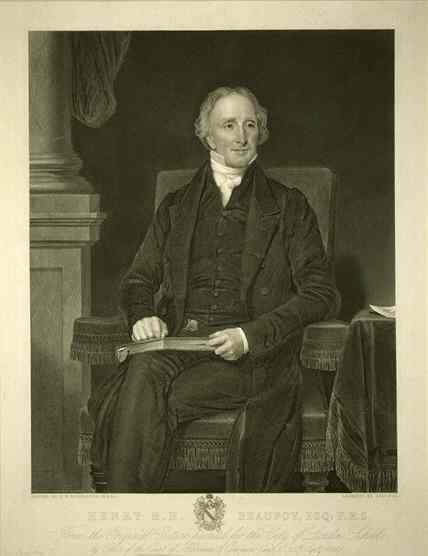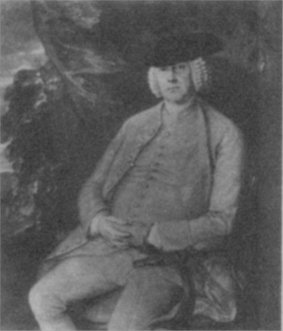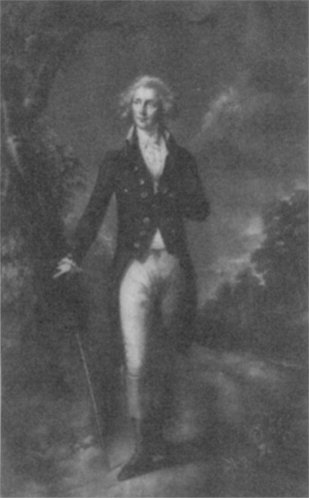I am privileged to have in my possession, a copy of a book first printed in 1930, called 'Leaves From A Beech Tree', by Gwendolyn Beaufoy. It is quite a comprehensively well-written and well-researched reference book on the Beaufoy's and serves the basis for the following pages.
The book's chapter headings are as follows:
- Leaves From A Beech Tree
- The Beaufoys Of Oxfordshire
- The Beaufoys Of Warwickshire From 1461 Till 1678
- The Beaufoys Of Meriden
- The Beaufoys Of South Lambeth
- Colonel Mark Beaufoy FRS
- Benjamin Beaufoy
- Captain Mark Beaufoy
- The Siddons Letters
- Henry Benjamin Hanbury Beaufoy FRS
This is not going to be the internet edition of the book however, that would take up far too much web-space. I shall start with The Beaufoys Of Meriden & Evesham
John Beaufoy of Evesham
John Beaufoy of Evesham was by trade a maltster, and later an oilman. He married in May, 1714, Mary Ramell, also of Evesham. They had four children : Elizabeth who married Jonothan Nelson ; Mary, married to Joseph Biddle (Mayor of Evesham) ; Mark, born October 1718 and Sarah, 1720. John died at an early age in 1722.
Mark was evidently looked after by an uncle, his mother's brother, Thomas Ramell, during his minority, and was apprenticed to the Distillery at Bristol in 1734, when he was sixteen. He afterwards took up vinegar brewing, it is said because he was so impressed by Hogarth's pictures of Gin Lane that he went over to Holland and there learned the art of making vinegar, which has been the business of the Beaufoy family ever since 1740, the actual Brewery being founded 1730.
Mark married at Bristol on July 15th 1743, Elizabeth, daughter of Capel Hanbury of Bristol and Pontymoil, who had died in 1740, her mother being an heiress, Elizabeth Newton. Mark and Elizabeth had 6 children. The first and third children, Elizabeth and Mary both died when a few weeks old; Henry the eldest son was born at Cuper's Bridge, November 1750; Maria (Mary) in 1755, John Hanbury in 1763 and Mark in 1764. His wife died in September 1772. Mark died at his house, Cuper's Bridge, where he had lived since his marriage in 1743, on February 11th, 1782. In Wilkinson's Londini Illustrata and Pennant's London are given descriptions of the works at Cuper's Garden.
The Beaufoys of South Lambeth
Henry Beaufoy M.P.
Henry, the eldest son of Mark Beaufoy had a short but brilliant career. Dying at the early age of forty five in 1795 at Clifton, near Bristol, he was buried at Ealing, and has a monument in that church to his memory. He possessed a country villa in this parish on Castlebeare Hill, which belonged after his death to HRH the Duke of Kent and then to Mrs Fitzherbert. In the year 1783 four alms houses were built on the Uxbridge Road for poor families, with part of a sum of money given to the parish by Henry Beaufoy, as a compensation for enclosing a piece of waste land. In 1794, four more were built at Old Brentford with the remainder of the money, but none of them were endowed. Henry seems to have been clever out of the ordinary, as a small child he was spoken of as being advanced in his studies for his age, and his Essays that he sent his father are simply astounding compositions for a child of thirteen. Gainsborough painted portraits of him and his wife, they both belonged to his brother, John Hanbury Beaufoy, and used to hang in the latter's house in Grosvenor Place and afterwards at Upton Grey.
About 1770, Henry fell in love with his future wife, Elizabeth, daughter and co-heiress of William Jenks, of Shiffnal, Salop. But owing to the diference in their religions they were unable to gain the consent - he from his father, and she from her uncle and guardian, Plowden Slaney. They eloped and were supported by Henry's cousin, William Biddle.
In 1775 Henry became a partner in his father's business, Beaufoy, Biddle & James, but never took an active part owing to his Parliamentary duties. He stood for Bridgenorth about the time of his marriage, was the (last) Member for Minehead, and later for Great Yarmouth. Twice he introduced a Bill for the repeal of the 'Test and Corporation Act' and his speeches are quoted at length in Lecky's History Of England. When the government, under the younger Pitt, assumed control of the East India Company, Henry Beaufoy was appointed Secretary of the Board. On being returned to Great Yarmouth it was as the nominee of William Pitt, to whom he was secretary.
He strongly advocated and assisted the Scotch Fisheries, for which he received a presentation and an address from the Highland Society
John Hanbury Beaufoy
John Hanbury, the second son of Mark Beaufoy and Elizabeth Hanbury, was born at Cuper's Bridge 17th February 1761. Originally intended for the medical profession he went to the University of Edinburgh, after being educated at Burford and the Dissenting Academy at Warrington, wich his elder brother, Henry, also attended. He was head of the Firm for many years, having a house in Grosvenor Place and a country seat, Upton Grey in Hampshire. But after his nephew Henry had become capable of managing the business, he retired to his country seat, only coming up to South Lambeth once a month. John Beaufoy seems to have been a keen sportsman, loving a god horse and enjoying his hunting and shooting. He married Agnes on 29th May 1796 at St. Margaret's, Westminster. He took his part in local affairs being High Sheriff for Hampshire in 1806 and deputy Lieutenant later. When the invasion scare was rife he entered the Westminster Light Horse, remaining in that regiment many years and retiring as Lieut.Colonel. He died on November 28th 1836 and is buried at Upton Grey.
Cuper's Gardens originally was a pleasure resort, and noted for fireworks but was frequented by undesirable characters of both sexes. In 1822 the Strand Bridge Committee took it over and built what is now called Waterloo Bridge, the Surrey side being on the site of the old Vinegar Brewery and Gardens.
Colonel Mark Beaufoy FRS
The third and youngest son of Mark and Elizabeth was born at Cuper's Bridge
the 4th of March, 1764. He was therefore only a child of eight years and a few months when his mother died in 1772. When Mark was only twenty he eloped with his cousin, Margaretta Beaufoy, daughter of Benjamin. They wedded in Scotland, lie so many lovers were at that period, at Gretna Green. Mark and his bride crossed the Channel and travelled to Neuchatel where they lived until 1787. Mark, like his eldest brother Henry, was a brilliantly clever man, and besides writing various articles on scientific maters, navigation and astronomy, had the honour of being the first Englishman to ascend Mont Blanc. He had an Astronomical Observatory at Bushey Heath and corresponded with the leading astronomers of his day both at home and abroad. The famous ascent to the summit of Mont Blanc from the village of Chamouni took place on the 8th of August, 1787.
Henry Benjamin Hanbury Beaufoy, FRS
The eldest of Mark and Margaretta’s sons was born in Switzerland. From letters one gathers that all his family and relations, especially those at Upton Grey, counted on his help and opinions a great deal. John Hanbury Beaufoy left him the business and house at South Lambeth, but with such heavy charges for his wife and others that his heir was crippled for years. My father-in-law says of him ‘Henry Benjamin Hanbury Beaufoy probably was a very able man. His early disappointment as to his inheritance must, I fancy, have greatly chagrined him. He lived a very quiet life at Lambeth and devoted a great deal of time and spent considerable sums of money collecting books etc. He had for many years as a companion a Miss Eliza Taylor, at one time a Columbine at Astley’s.
Quite late in life he married her, and his family paid her the compliment of calling on her at once. I fancy she must have been not only a very charming, but a very good woman, and her husband did not long survive her death. He gave large sums, not less than £10,000, to the City Of London School for scholarships; and also built at a cost of £10,000 the Beaufoy Ragged School (Now taken over by the L.C.C and known as the Beaufoy Institute)’. Eliza died in 1847 and Henry in 1851. He left the business to his brother George.
George Beaufoy, R.N
George Beaufoy, R.N., the youngest son and seventh child of the Colonel, was born at Hackney Wick on October 14th, 1796, so that he was four years and ten months old when his mother died, and the baby, Laura, only eighteen , months. Harriet, the eldest, although only fifteen seems to have been looked on by all the family as a second parent up to the time she married in 1817. George entered the Navy in 1810 and retired as captain in 1851. He married in 1852 Anne Harvey, and had three children, George, who died in infancy; Mark Hanbury, born 1854, died 1922; and Margaretta born 1859, who married Temple Cooke, Barrister-At-Law, and Recorder of Southampton. Mark Hanbury Beaufoy was educated at Eton and trinity Hall, Cambridge. Member of Parliament for Kennington from 1889 to 1895. High Sheriff for Wilts, 1900, and lived at Coombe House, near Shaftesbury, which he built about 1887. He is the author of some doggerel verses on shooting, which seem to have reached every corner of the English speaking world, and were written for his eldest son, Henry Mark, when he first started to shoot, and entitled
‘A Father’s Advice.
If a sportsman true you’d be,
Listen carefully to me
Never, never let your gun
Pointed be at anyone;
That it may unloaded be
Matters not the least to me.
When a hedge or fence you cross,
Though of time it cause a loss,
From your gun the cartridge take
For the greater safety sake.
If ‘twixt you and neighbouring gun
Bird may fly or beast may run,
Let this maxim e’er be thine:
‘Follow not across the line.’
Stops and beaters, oft unseen,
Lurk behind some leafy screen;
Calm and steady always be;
‘Never shoot where you can’t see’
Keep your place and silent be;
Game can hear and game can see;
Don’t be greedy, better spared
Is a pheasant than one shared.
You may kill or you may miss,
But at all times think of this –
‘All the pheasants ever bred
Won’t repay for one man dead.’
This information has been taken (directly) from ‘Leaves From A Beech Tree’ by Gwendolyn Beaufoy, first printed for the author in 1930 by Basil Blackwell Oxford. This book is very rare, I do not know how many were printed but I have a copy. It has various illustrations, some of which are Gainsborough paintings. I would try to scan them but naturally, I would not want to damage the book.


